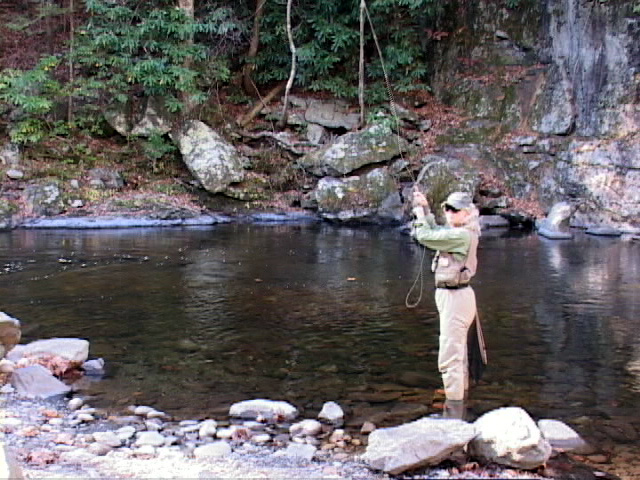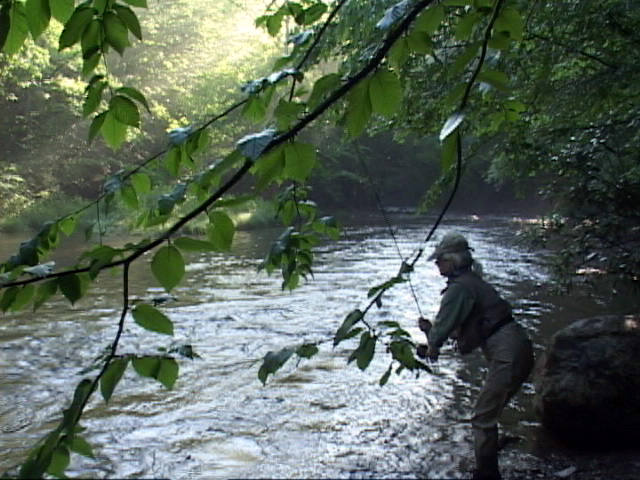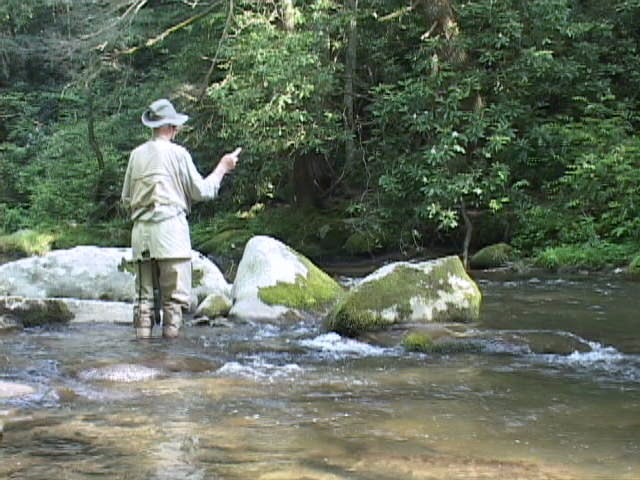
of types of water from large,
deep pools to fast runs and
shallow riffles. It would best
be described in one phrase
as pocket water.

Trout for the Little River They
do get much larger. In
addition there are brown trout
and brook trout in its
headwaters.

Trout for the Little River
probably averages about 7
inches. Browns grow much
larger.

River can make getting around
tough but they also help create
the excellent habitat.

River will usually produce fish.

the hot summer months.

best. Pocket water consist of a
mixture of little pools, plunges,
tiny runs, short riffles, eddies
and slow, medium and fast
currents.

almost always hold trout. It
provides a place for the trout to
move in and feed that is close
to deep water that provides the
security they need from
predators.

relatively large stream.

above Elkmont.

brown trout in Little River.
Description:
The East Prong of the Little River, commonly referred to a “Little River”, is one of the largest of the Great Smoky Mountains National park’s streams. It’s also the heaviest fished stream in the park for two prime reasons. One, much of the stream is easily accessed from a paved road that closely follows the stream from its lower portion all the way past the Elkmont Campground. The other reason is simply the fact that it’s one of the better streams in the park to fish. Its brown trout run as large as any in the park and its rainbow trout are plentiful.
Species:
Brown and rainbow trout are present in the lower and middle sections of the stream and brook trout can be found in its uppermost part and some of its tributary streams.
Difficulty:
The difficulty of fishing Little River ranges from easy to difficult depending on where and when you are fishing. Most of the stream is fairly easy to negotiate. Some of it isn’t. Most of it can be easily cast too, but in some places, it’s difficult to cast.
Popularity:
Little River is probably the most popular fly-fishing destination in the Great Smoky Mountain National Park.
Main Portion (West, Middle and East Prongs):
From the point the three prongs of this stream flow together at an area known locally as the “Y”, the Little River becomes quite large in small stream terms. There’s only a short section of this main part of the stream that’s within the park’s boundaries. Trout found here are usually difficult to catch during the warmer parts of the year because the water temperatures can be warm enough to deplete the oxygen content to the point the trout become lethargic. This portion is best fished during the cooler seasons of the year.
The “Y” to Meigs Creek:
During the hottest parts of the year, water in the East Prong upstream of the “Y” as far as the confluence of Meigs Creek becomes warmer than that preferred by the trout, especially the rainbows. This section of the stream contains some very large, deep pools that are difficult to fish and some very rough and difficult to navigate pocket water in what is called the “Little River Gorge”. Caution should be used when fishing this part of the stream, especially if the water is running higher than normal. The water runs very swift in some parts and can be risky to wade. Also, keep in mind that it’s not a rare occasion for someone to fall from the high steep banks that border the stream in many areas, so anglers should be cautious about falling.
Meigs Creek to Metcalf Bottoms:
From Meigs Creek upstream past a low to medium gradient area known as “Metcalf Bottoms”, it’s still possible for the water to get above seventy degrees during the hottest parts of the summer. During these occasions, anglers would find better conditions farther upstream. Water temperatures above the waterfall at an area known locally as the “Sinks”, are normally agreeable to the trout. Most of the year the portion of the stream from the “Sinks” upstream to “Metcalf Bottoms” provides conditions that are agreeable to the trout.
The lower gradients found in Metcalf Bottoms and the associated picnic area is quite different in streambed composition from most of the river. This change provides a difference in the normal aquatic insect life. Hatches in this area can include some mayfly and caddisfly species not commonly found in most other areas of the stream. The slower moving water and the available aquatic insects in this area usually require a much different strategy and fly presentation than the normal pocket water found in most streams.
Metcalf Bottoms to Long Arm Bridge:
From Metcalf Bottoms upstream to the next bridge called Long Arm Bridge, the stream will change from the smoother flows to fast, turbulent rapids along with everything in between these two extremes. Normally, anglers will find that at least some portion of the changing stream conditions will be excellent for the trout. Be aware that some areas of this stretch of water with steep banks and fast water, deserve a cautious approach. You would not think so after watching numerous tubers and kayaks plunge downstream, but it is. During the warmer months of the year, you can count on a lot of this type of activity from this point all the way to Townsend. During those times, you may consider fishing very early or late in the day. After all, that isn’t a bad strategy to utilize during the summertime for reasons other than the interference from the water lovers. Respect their rights to the water.
Long Arm Bridge to Elkmont Campground:
From the Long Arm Bridge all the way upstream to the Elkmont Campground, one would be hard pressed to find a stretch of water that didn’t contain a good population of both rainbow and brown trout. However, as you may expect, this section is far from being a secret getaway destination. It’s fished as heavily or heavier than any section of water in the park but it’s for very good reasons, primarily easy access and lots of willing trout. This area contains the classic pool, riffle, run stream makeup that allows the trout the opportunity to select prime lies throughout the changing seasons. You may occasionally become frustrated with tubers in this area, but much less frequently than downstream.
Elkmont Campground upstream:
From the Elkmont Campground upstream it’s slightly over four miles to its major tributary stream, Fish Camp Prong. In this section, the Little River provides the idea habitat for rainbows. You will find that the population of brown trout decreases the farther upstream you venture but the stream still has plenty of them. The stream stays larger than one may expect all the way to the Fish Camp Prong, but from that point upstream, Little River is much smaller. Since this part of Little River cannot be accessed by automobile, it receives much less fishing pressure. Don’t expect to be the only angler there, however, unless you leave very early or spend the night at an upstream back country campsite.
Tributary Streams:
Little River has several tributary streams some of which are major ones.
Meigs Creek:
Meigs Creek is a very small stream that enters the Little River just below the Sinks. Its mouth is easy to spot because Meigs Falls can be seen from the road that borders Little River. Brook trout would be the reason to fish this stream.
Blanket Creek:
Blanket Creek is a very small tributary of the Little River that’s hardly worth mentioning.
Laurel Creek:
Just upstream, Laurel Creek is another small tributary stream that has a population of small rainbows and brook trout in its upper reaches.
Jakes Creek:
Jakes Creek is yet another small tributary of Little River that intersects the stream in the Elkmont Campground. Small rainbows make up the bulk of its fish. It’s questionable as to whether one should attempt to fish either of these small tributary streams mentioned so far, especially since they have to pass up Little River to do so. High water in the Little River may be the only justifiable reason to fish either of them.
Fish Camp Prong:
Fish Camp Prong is a major source of water for the Little River. Since it’s about four miles upstream from the Little River Trailhead, it means that you would probably need to stay at a remote campsite to fish it. Rainbow and brook trout in its headwaters are the main attractions of this stream although a few browns may be present in its lower reaches.
Rough Creek:
Rough Creek is yet another small tributary stream of Little River. Small rainbows make up the bulk of its trout along with some brook trout. It’s best fished from a back country campsite.
Comments:
Little River has the best of two different types of access. Paved roads and excellent backcounty trails. Its population of rainbow and brown trout, some of which grow to a large size, makes it one of the prime Smoky Mountains National Park fly fishing destinations.
Copyright 2011 James Marsh










